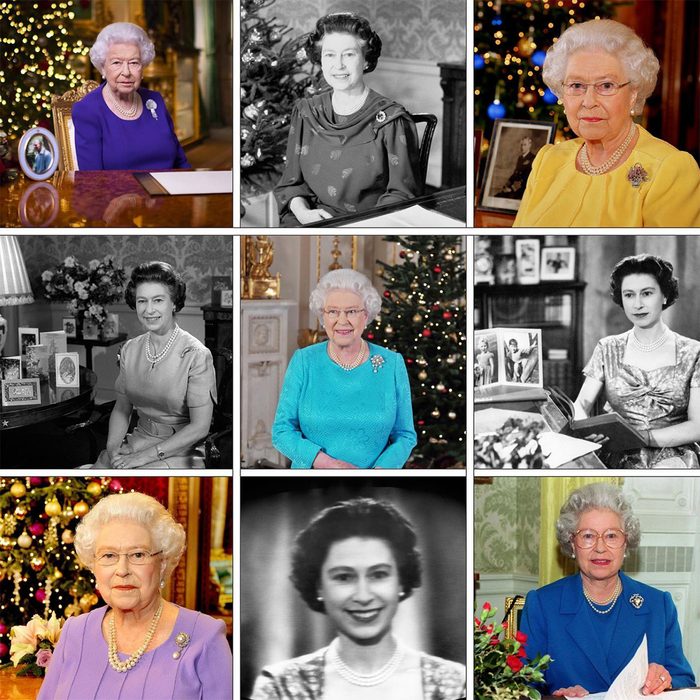
Celebrating the Queen’s Platinum Jubilee in Canada
Queen Elizabeth II is the only monarch most of us have ever known. She has witnessed firsthand several key moments in Canadian history, including the opening of the St. Lawrence Seaway in 1959, Expo 67 in Montreal, and the patriation of the Canadian Constitution in 1982. Through all the political, social, and cultural change of her long reign, she has remained a figure of stability and continuity.
On Feb. 6, 2022, the Queen marked the 70th anniversary of her accession to the throne. From Sandringham House in Norfolk, she released a historic statement declaring, “I look forward to continuing to serve you with all my heart,” demonstrating that she has every intention of continuing to reign—and to achieve new milestones. If she reigns for 72 years, she will surpass King Louis XIV of France’s record as the longest reigning monarch in European history. At the moment, she is of course the longest reigning monarch in British and Commonwealth history, and the first sovereign to celebrate a Platinum Jubilee in honour of a 70-year reign.
The public celebration of this historic milestone will take place later in 2022. In the United Kingdom, there will be a four-day holiday weekend in June (Thursday, June 2 to Sunday, June 5), which will include a parade, a church service, a party at the palace and a jubilee pageant telling the story of the Queen’s record-breaking reign.
In Canada, communities have been encouraged to apply to the Department of Canadian Heritage for funding for local celebrations such as street parties and fireworks displays. On June 3, Platinum Jubilee Beacons (ceremonial torch flames) will be lit in each of the Commonwealth capitals, including Ottawa. The Canadian capital is also planning to illuminate the historic Byward Market with royal purple lights in honour of the occasion. More plans for the Canadian celebration of the Platinum Jubilee include commemorative coins and stamps, historical exhibitions featuring images of the monarch from her 22 official visits to Canada as Queen, and a sound and light show on Parliament Hill from July to September.
While Queen Elizabeth II is the first monarch to celebrate a Platinum Jubilee, there is a rich history of Silver (25th anniversary), Golden (50th anniversary) and Diamond (60th anniversary) royal jubilee traditions to draw upon for this year’s celebrations. Here are 10 royal jubilee traditions from the past few centuries that will likely reappear in one form or another in 2022.
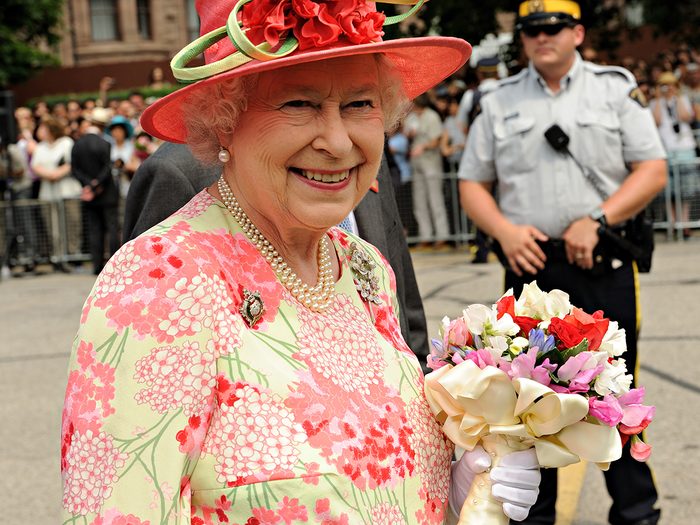
A Royal Tour
The Golden Jubilee of King George III (1809-1810), and the Golden (1887) and Diamond (1897) Jubilees of Queen Victoria were celebrated throughout the British Empire, but members of the royal family were not expected to travel to all these festivities in person. That changed during the reign of Queen Elizabeth II, who made her role as Head of a Commonwealth of equal nations a key priority throughout her reign and became the best-travelled monarch in history.
To celebrate the Golden Jubilee in 2002, the Queen and her husband, Prince Philip, Duke of Edinburgh, toured Canada, Australia, Jamaica and New Zealand. Ten years later, the couple toured the United Kingdom while their children and grandchildren toured the Commonwealth including a visit to Canada by Charles and Camilla.
For the Platinum Jubilee, Charles and Camilla returned to Canada for a three-day tour, which kicked off in St. John’s on May 17, 2022. Two months earlier, Prince William and Kate, the Duke and Duchess of Cambridge, toured the Caribbean.
Take a look back at the most memorable royal tours in Canadian history.
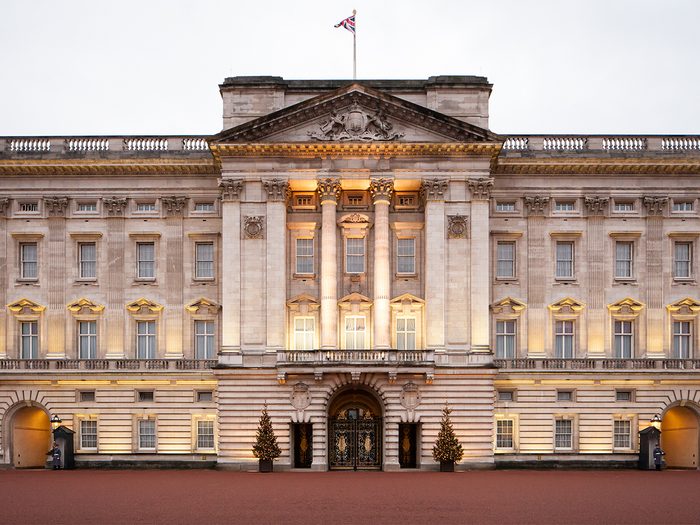
A Concert
Music has always been a key part of royal jubilee celebrations. When Golden Jubilee celebrations in honour of King George III began in 1809, church bells were rung and communities across the British Empire held balls and concerts. For her Diamond Jubilee in 1897, Queen Victoria listened to an arrangement of a celebratory Te Deum (thanksgiving hymn) created by her late husband, Prince Albert, as well one of his personal compositions, an anthem called “Gotha,” in honour of his birthplace, the German Duchy of Saxe-Coburg and Gotha.
For Queen Elizabeth II’s Golden Jubilee in 2002, the grounds of Buckingham Palace were opened to the public for the first time with a pop concert including performances by Queen, Elton John, Tom Jones, Paul McCartney, Annie Lennox and Canada’s own Bryan Adams. 12,500 members of the public received their “golden ticket” in a lottery to attend in person; a million more gathered on the Mall outside Buckingham Palace to watch the concert on giant screens, while a further 20 million in the United Kingdom and 200 million worldwide watched the event on television. The concert included iconic moments such as Brian May from Queen performing God Save the Queen on the roof of the palace and Paul McCartney singing, “Her Majesty’s a pretty nice girl.”
The Diamond Jubilee concert in 2012 took place on the Mall in the presence of the Queen and members of the royal family, along with hundreds of thousands of concert goers. Gary Barlow and Andrew Lloyd Webber composed a new song, “Sing,” in honour of the occasion.
This year’s Platinum Party at the Palace will take place on June 4, 2022.
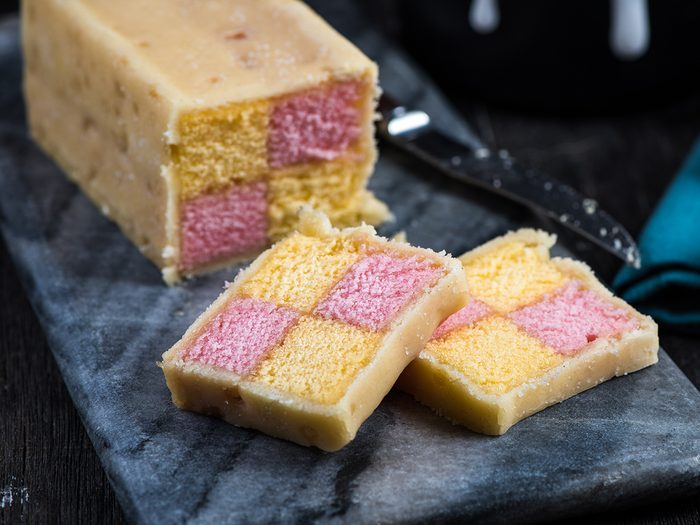
A New Dessert
Royal occasions have long been an opportunity to showcase new dishes—especially desserts.
Modern baking powder was invented in 1843, a few years into Queen Victoria’s reign, allowing for lighter and fluffier cakes. The royal family helped to popularize these new confections: Victoria sponge cake became a fixture at Queen Victoria’s teas and the Battenberg Cake (above) was invented in 1884 when Queen Victoria’s granddaughter, Victoria of Hesse-Darmstadt, married Prince Louis of Battenberg. The highly symbolic cake not only combined German marzipan and English apricot jam, but the two-by-two checkerboard pattern inside the cake represented the groom and his three brothers, the four Battenberg princes.
The tradition of coming up with new dishes to celebrate royal occasions expanded in Queen Elizabeth II’s reign, with the creation of spiced coronation chicken to fulfill the need for a cold, tasty and filling dish to feed hundreds of guests at the Queen’s coronation in 1953. Attendees at the Queen’s Golden Jubilee Party at the Palace concert in 2002 received picnic lunches of jubilee chicken. For the Diamond Jubilee, Royal Chef Mark Flanagan and famous British chef Heston Blumenthal created Diamond Jubilee Strawberry Crumble Crunch for the picnic at Buckingham Palace. A British supermarket reported that sales of elderflower cordial, an obscure ingredient called for in the recipe, increased 1,000% as people tried to recreate the dish at home.
For this year’s Platinum Jubilee, residents of the United Kingdom aged eight and up were invited to enter the Platinum Jubilee Pudding Contest to create the perfect dessert for the Jubilee Lunch. You can check out the winner here.
Check out 10 Canadian hotels that have hosted royal guests.
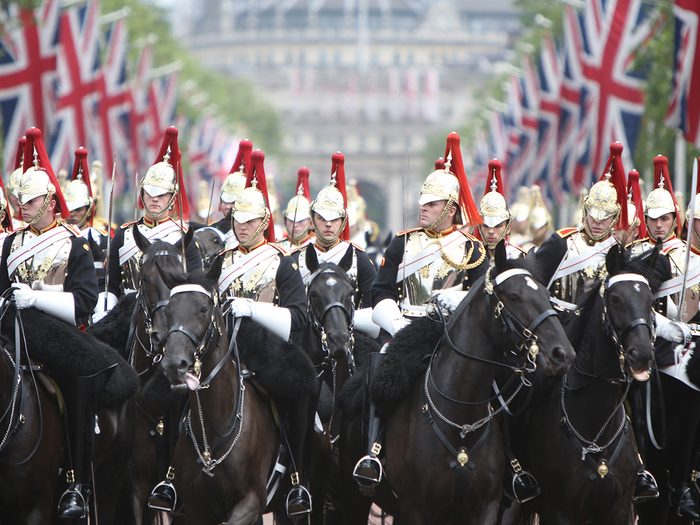
A Parade and Pageant for the Queen’s Birthday
Pomp and pageantry are central to royal jubilee celebrations around the world.
In the United Kingdom, the official celebrations for the monarch’s birthday—including the Trooping the Colour parade (above) in which the monarch reviews the troops in the role of Commander-in-Chief—take place in June, regardless of the date of the King or Queen’s actual birthday. During a jubilee year, Trooping the Colour becomes part of the celebrations as the royal family appears on the Buckingham Palace balcony after the parade and military review while the public gathers on the Mall. This year’s Platinum Jubilee Trooping the Colour Parade will take place in London on June 2.
On Sunday, June 5 (the final day of the UK’s Jubilee long weekend), dancers, musicians, military personnel, essential workers and volunteers will come together to participate in a Platinum Jubilee Pageant which will tell the story of the Queen’s 70-year reign. Across the Commonwealth, town criers will announce the Jubilee, including a bilingual town crier in Ottawa.
In Canada, the Queen’s official birthday is Victoria Day (the last Monday on or before May 24th), and this year, it will likely be one of the busiest days for jubilee celebrations on the Canadian calendar. In Ottawa, Northern Lights 2022, a sound and light show on Parliament Hill, which opens in July, will feature a special segment to mark the Platinum Jubilee including historical photos and animation to showcase the Queen’s visits to Canada over the course of her reign.
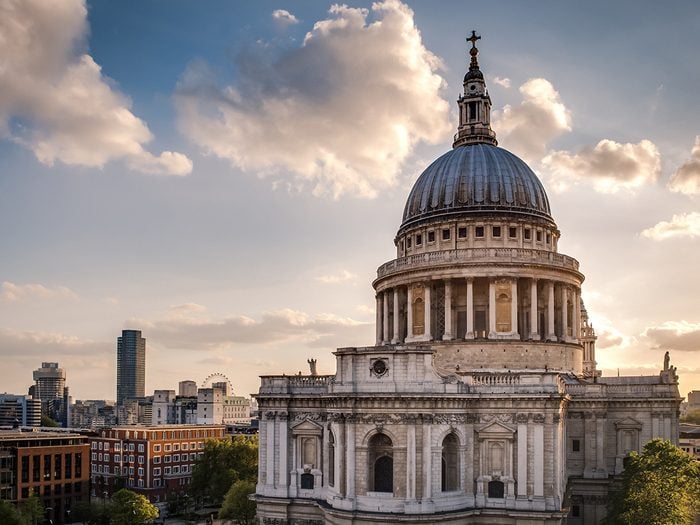
A Service of Thanksgiving
One of the most consistent royal jubilee traditions over the years are church services of thanksgiving to celebrate a monarch’s long reign.
For George III’s Golden Jubilee, the royal family attended services privately at Windsor, but the Lord Mayor of London and civic officials led a procession to London’s St. Paul’s Cathedral (above) to commemorate the occasion. Queen Victoria also attended services of thanksgiving for her Golden and Diamond Jubilees. In 1897, the service took place outside St. Paul’s because the elderly Victoria was unable to climb the steps to the cathedral.
In Canada, October Thanksgiving holiday celebrations in 1887 and 1897 were royal jubilee-themed, and Canadians were encouraged to count Queen Victoria’s long reign among their blessings as they carved their turkeys.
In 2012, coverage of the service of thanksgiving for Queen Elizabeth II’s Diamond Jubilee noted that the Queen appeared to be lonely because Prince Philip was not at her side: he was in the hospital at the time, recovering from a bladder infection. This year’s Platinum Jubilee service at St. Paul’s Cathedral on June 3 will likely attract intense press coverage, partly because it will be the first time the Queen’s family has come together as a group since Prince Philip’s memorial service on March 29.
Although the service will not be open to the public, there will likely be opportunities for the public to see the extended royal family travel to and from the cathedral.
Places of worship and civic institutions across the Commonwealth—including Canada—will hold their own commemorations of the Queen’s Platinum Jubilee. One such service, Accession Day Evensong at the Cathedral Church of St. James in Toronto, held on Feb. 6, 2022, was attended by Lieutenant Governor of Ontario, Elizabeth Dowdeswell.
Check out these rarely-seen photos of Elizabeth before she became Queen.
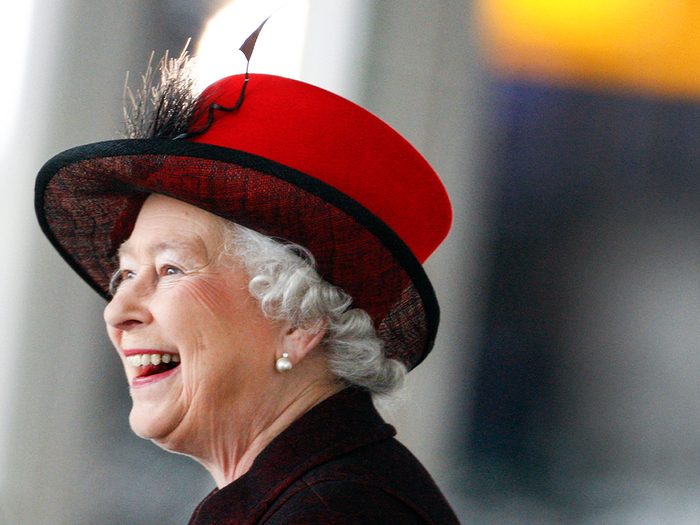
A Philanthropic Initiative
The royal family has been deeply involved in philanthropy since the reign of King George III and royal jubilee celebrations are an opportunity to launch new charitable initiatives that bring together the United Kingdom and Commonwealth.
Back in 1896, Canada’s National Council of Women met in Halifax and passed a resolution asking Lady Aberdeen, the wife of the Governor General, to found an order of nurses to provide home care in honour of Queen Victoria’s upcoming Diamond Jubilee. Prime Minister Wilfrid Laurier presented a motion in parliament for the inauguration of the new nursing order the following year. In November 1897, Queen Victoria granted a royal charter to the Victorian Order of Nurses (VON), which still provides home nursing care in Canada today.
King George V’s Silver Jubilee Trust Fund raised money for children in need during the Great Depression of the 1930s and continues to operate programs in the United Kingdom.
The Silver Jubilee in 1977 was the first big jubilee celebration of Queen Elizabeth II’s reign. To mark the occasion, the Queen Elizabeth II Silver Jubilee Trust was founded with the goal of creating new opportunities for young people throughout the Commonwealth. In Canada, the Queen Elizabeth II Silver Jubilee Endowment Fund for Study in a Second Language provides funding for young Canadians interested in increasing their proficiency in another language.
For the Platinum Jubilee, tree-planting is being encouraged to contribute to The Queen’s Green Canopy. There will likely be further charitable initiatives announced in the coming months to honour the Platinum Jubilee in Canada.
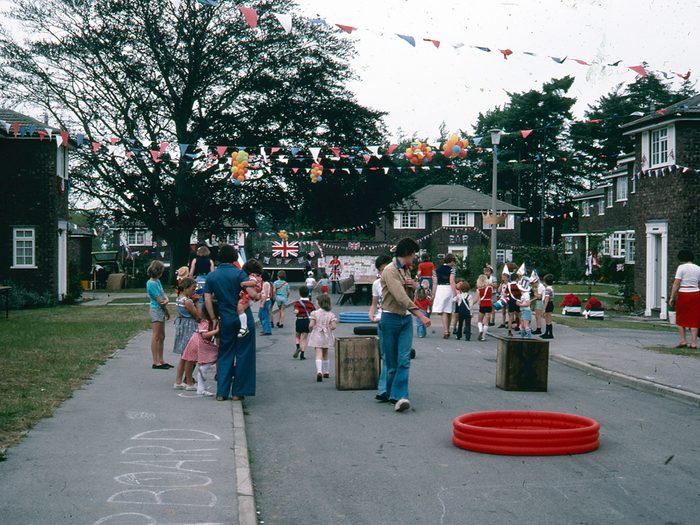
Street Parties
Royal jubilees have always been opportunities for families, friends and neighbours to come together and celebrate with food and drink.
During King George III’s Golden Jubilee year, hundreds of oxen donated by businesses and wealthy landowners were roasted across the United Kingdom for celebratory public dinners, and participants in these Jubilee Ox Roasts were given commemorative plates and knives. These occasions broke down social class barriers for a short time, as the underprivileged were provided with free meals.
Although roasted meats continued to be popular at street parties commemorating Queen Victoria’s Golden and Diamond Jubilees, jubilee cuisine became more diverse over the course of Queen Elizabeth II’s reign. Immigrants to the United Kingdom from the Commonwealth and beyond brought their own culinary traditions to the celebrations, and street party menus took on an increasingly international flair, influenced by Indian, Caribbean and African cuisines. At the same time, the format of the meals shifted from roast dinners to more informal picnics and barbecues.
We can expect to see Platinum Jubilee street parties across Canada this summer, some of which will feature fireworks and musical performances as well as communities coming together for a celebratory meal. If you’re interested in establishing a street party in your own community, you can apply to Canadian Heritage for funding.
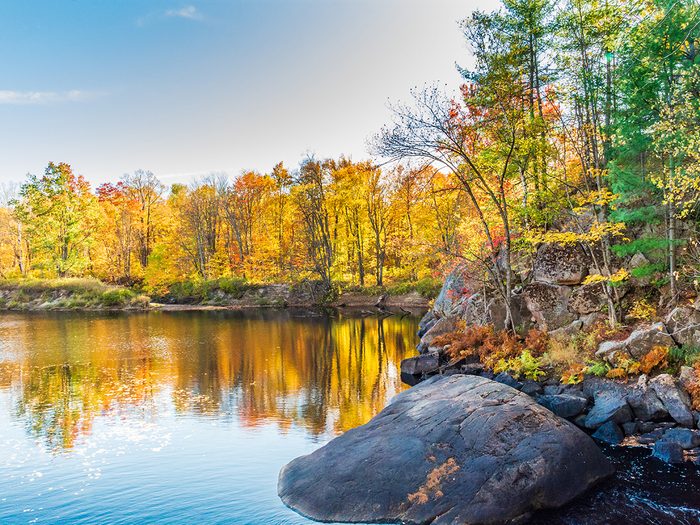
New Names For Public Spaces
In honour of the Queen’s Platinum Jubilee, Australia announced that Aspen Island in the national capital, Canberra, will be renamed “Queen Elizabeth II Island.” This is the latest in a long tradition of establishing (or at least renaming) gardens and parks to celebrate a royal jubilee.
For the Queen’s Golden Jubilee in 2002, the Ontario government renamed a provincial park in her honour. Dalton Digby Wildlands Provincial Park near Gravenhurst, the second largest in the Ontario Parks system after Algonquin, became the Queen Elizabeth II Wildlands Provincial Park (above). This year, lieutenant governors and territorial commissioners will continue the tradition with the dedication of jubilee gardens across the country. Ontario’s Platinum Jubilee Garden will be planted at Queen’s Park and designed in partnership with Elder Carolyn King of the Mississaugas of the Credit First Nation. The garden will have a focus on the historical treaty relationship between the Crown and Indigenous peoples.
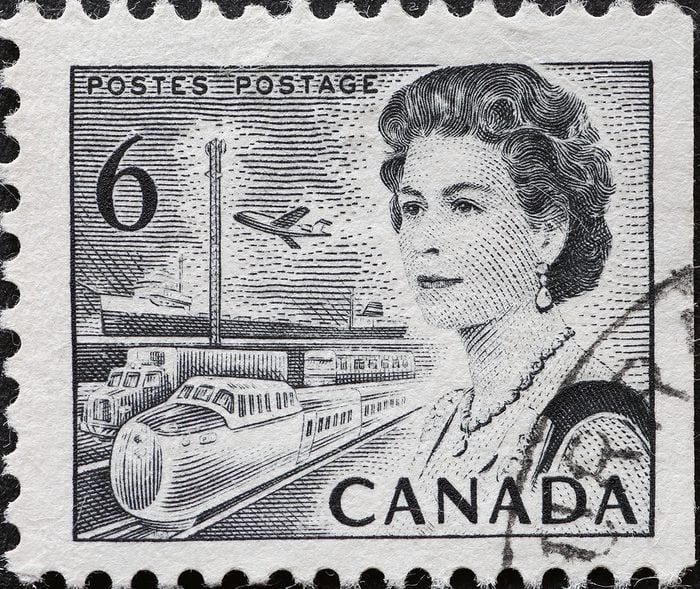
Exhibitions Showcasing Royal History
When Queen Victoria celebrated her Diamond Jubilee in 1897, she allowed the rooms where she’d lived in Kensington Palace during her childhood to be opened to the public for the first time. The exhibition was groundbreaking because it allowed the public to literally follow in the footsteps of royalty and enjoy a behind-the-scenes glimpse of the monarch’s childhood home.
These days, Kensington Palace is just one of many royal residences open to the public, and a popular tourist attraction in London. A number of these royal residences will be hosting historical exhibitions in 2022 in honour of Queen Elizabeth II’s Platinum Jubilee. At Windsor Castle, visitors will be able to admire the Queen’s coronation dress, while the Palace of Holyroodhouse in Edinburgh will play host to her fashions from the Silver, Golden and Diamond Jubilees.
The Canadian Museum of History in Gatineau, Quebec, currently showcases an online exhibition of “The Queen’s Stamps,” documenting Queen Elizabeth II’s image on Canadian postage stamps, which date back to her grandfather George V’s Silver Jubilee in 1935. On February 6, plans for an outdoor exhibition (“The Queen and Canada”) on the terrace of Ottawa’s Chateau Laurier were announced, which will include photos of the Queen in Canada at key moments in history. There will also be a Platinum Jubilee exhibit at the Canadian Museum of Nature, including specimens of platinum as well as the guest book signed by the Queen and Prince Philip when they visited the museum in 2010.
Here’s what will happen when Prince Charles becomes king.
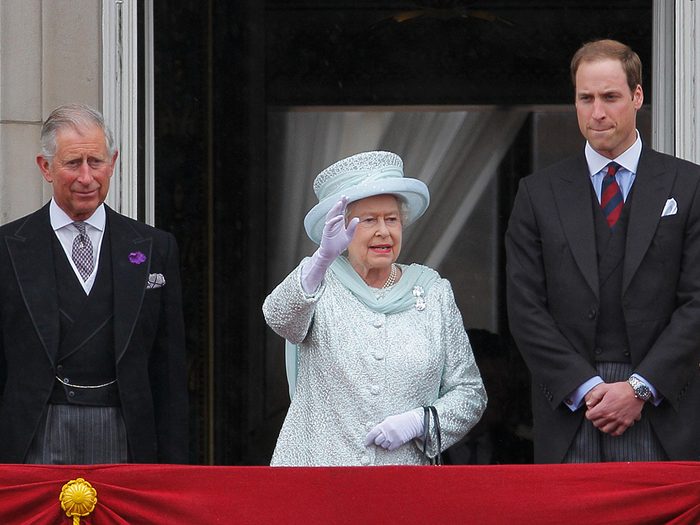
A Debate about the Future of the Monarchy
A royal jubilee is not only an opportunity to commemorate the history of the monarchy and the many decades of a king or queen’s public service. These milestones also prompt discussion and debate about the current state of the monarchy and its future.
When King George III entered the 50th year of his reign in 1809, not all the press coverage was celebratory. Some commentators looked back on how prices had risen over the previous 50 years and how the American colonies had been lost to the British Empire during the American Revolutionary Wars. Then, as now, the Duke of York was in disgrace, casting a shadow over the celebrations. All of these circumstances prompted a robust popular debate about the state of the House of Hanover in the early 19th century.
Later that century, Queen Victoria received more complimentary jubilee coverage. She had faced criticism in the 1860s over her seclusion in the decade following the death of her husband, Prince Albert, but by her Golden and Diamond Jubilees, she was once again undertaking public engagements and was viewed as both “the grandmother of Europe” and the head of a global British Empire.
The popularity of the monarchy during Queen Elizabeth II’s reign has varied over the past 70 years, shaping contemporary media coverage of her jubilees. There were concerns that there would be little public interest in her Silver Jubilee in 1977 because of difficult economic times; likewise, that her 2002 Golden Jubilee would be overshadowed by royal scandals and the death of Diana, Princess of Wales. Nevertheless, the crowds came out for royal tours and festivities.
On the eve of the Queen’s Golden Jubilee tour of Canada in October 2002, Canada’s Deputy Prime Minister John Manley declared, “I don’t think it’s necessary for Canada to continue with the monarchy.” The public—and press—challenged these comments by reaffirming the Queen’s role in Canadian history, and their continued support for her reign. Recent royal tours have highlighted reconciliation with Indigenous peoples, and that process will likely inform analysis of the past, present and future of the monarchy at the time of the jubilee.
Next, take a look back at the Queen’s incredible life in 30 quotes.